What Is a Cluster House? A Complete Homebuyers Guide
Curious what is a cluster house? Discover this unique housing option that blends private living with shared amenities, and find out if it's right for you.
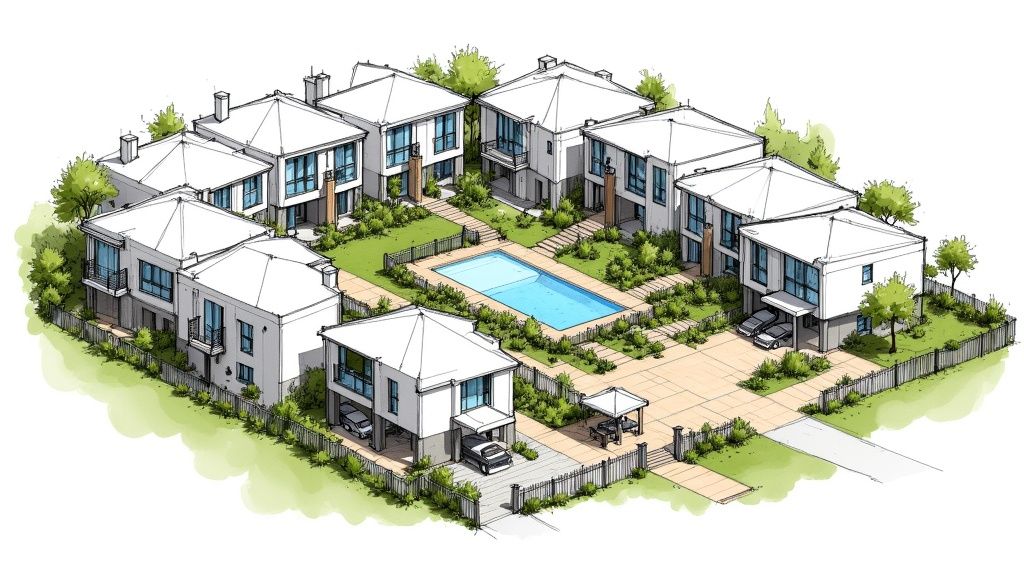
Ever found yourself torn between the spacious privacy of a landed house and the convenient, facility-rich lifestyle of a condominium? In Singapore, there’s a housing type that elegantly solves this dilemma: the cluster house.
Think of a cluster house as a hybrid home. You get the multi-storey space and individual entrance of a traditional landed property, but it's situated within a private community that shares fantastic amenities like swimming pools, gyms, and lush gardens. It’s the perfect blend of privacy with a condo lifestyle.
The Best of Both Worlds Explained
So, what does this actually look like? Imagine an exclusive enclave of private houses, all built on one large plot of land. Instead of each home having its own small, isolated yard to maintain, the houses are cleverly grouped together. This frees up a significant amount of land for expansive shared green spaces and top-notch recreational facilities for everyone to enjoy.
This design is all about fostering a close-knit community. Homes are often arranged in small, intimate groupings—typically between six to twelve units. This encourages neighbours to connect and build relationships, which is a key principle in community-centric architecture. In fact, design philosophies like those in Christopher Alexander's renowned book, A Pattern Language, suggest this size is perfect for creating a sense of belonging and making shared decisions feel more personal.
In essence, a cluster house gives you the prestige and generous space of landed living, but without the hassle of solitary upkeep. It’s a balanced, community-focused lifestyle.
Visualizing the Difference
To truly grasp the concept, let's compare how a cluster house development uses land versus traditional detached homes.
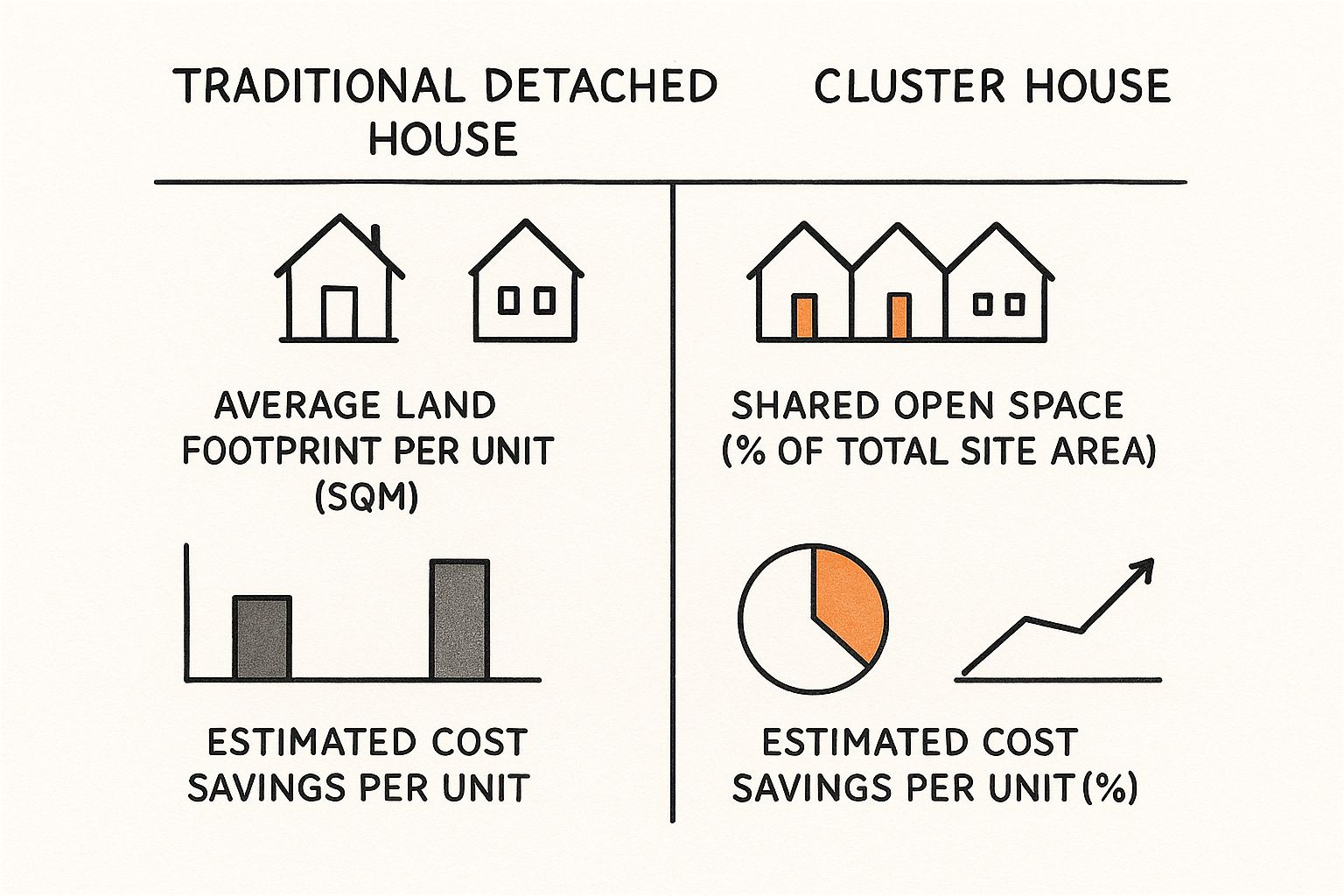
As you can see, this efficient land use not only creates more shared open space for residents but can also lead to significant cost savings. It’s an innovative approach that truly maximizes both your lifestyle and the value of your investment.
Cluster House vs Other Homes At a Glance
To make the distinctions clearer, here’s a quick comparison of key features between Cluster Houses, Condominiums, and traditional Landed Homes.
| Feature | Cluster House | Condominium | Landed Home |
|---|---|---|---|
| Housing Type | Strata-Titled Landed | Strata-Titled Apartment | Titled Landed |
| Privacy | High (Private home) | Moderate (Shared corridors) | Very High (Private plot) |
| Space | Large (Multi-storey) | Varies (Single-level unit) | Very Large (Multi-storey) |
| Facilities | Shared (Pool, gym, etc.) | Shared (Pool, gym, etc.) | Private (If any) |
| Maintenance | Managed by MCST | Managed by MCST | Owner's responsibility |
| Community | Small, tight-knit | Large, diverse | Varies by neighbourhood |
This table shows how cluster houses neatly fill the gap, offering a unique combination of features that appeal to those who want more than a condo but with less of the maintenance burden that comes with a traditional landed property.
What Makes a Cluster House a Cluster House?
So, what really sets a cluster house apart from other types of homes in Singapore? It boils down to a brilliant mix of private homeownership, clever architectural design, and shared community perks. It's not just a house; it's a lifestyle choice.
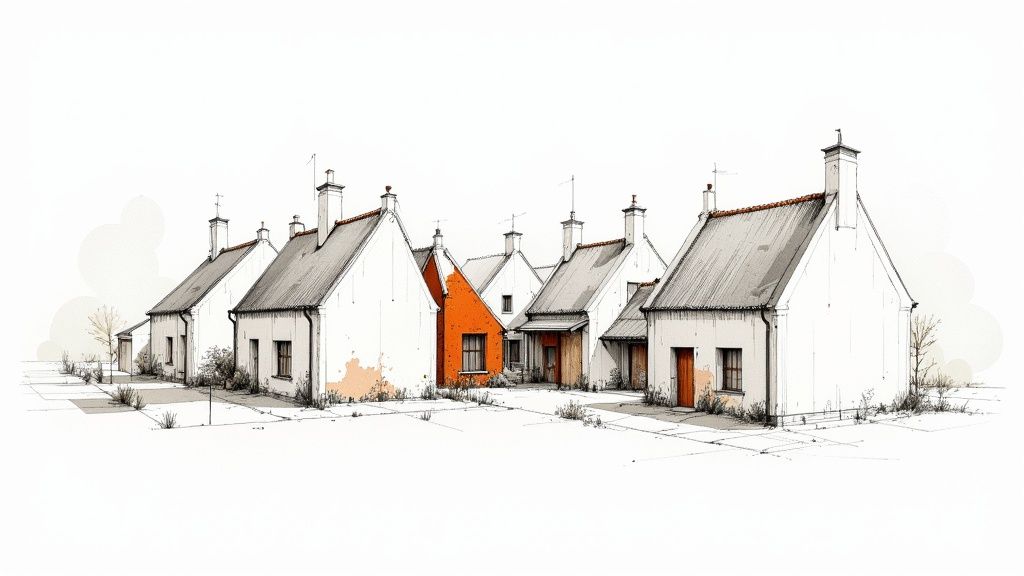
The ownership structure is the first piece of the puzzle. Cluster houses are sold on a strata title, which is a bit of a hybrid model. You get the title deed to your own house—the actual building is yours—but you share ownership of the land and all the common facilities with your neighbours.
It's a lot like owning a condo, except your "unit" is an entire landed house with multiple floors. This means you get the privacy and space of your own home, but the upkeep of the shared grounds is handled by a management corporation. No mowing the lawn yourself!
Multi-Storey Living with All the Trimmings
Architecturally, cluster homes are designed to go up. Most are multi-storey, typically rising three to five levels, which is a smart way to pack a lot of living space onto a smaller plot of land. This vertical layout naturally creates a great separation between social spaces, work areas, and private bedrooms.
On top of that, they often come with private perks you just don't get in an apartment:
- Private Car Park: Nearly all units have their own sheltered parking spots, usually tucked away in a shared basement with direct, private access right into your home.
- Private Lift: It’s common in many developments for each house to have its own internal lift, making it a breeze to move between floors.
- Rooftop Terrace or Garden: A private rooftop space is a frequent feature, offering a personal outdoor retreat for a quiet evening or a weekend BBQ.
The genius of the cluster house design lies in its ability to deliver the generous, multi-level space of a landed property while integrating the effortless lifestyle benefits of a modern condominium development.
The Best of Both Worlds: Pools, Gyms, and Green Spaces
The final, and perhaps most attractive, feature is the access to shared facilities. Instead of a small, private yard you have to maintain, you get to enjoy sprawling, professionally managed amenities.
This is where the condo experience really kicks in. You’ll find swimming pools, well-equipped gyms, children’s playgrounds, and function rooms right on your doorstep, all without the personal hassle of upkeep. It's this combination of a private, spacious home and luxurious shared facilities that truly defines the cluster house lifestyle.
Lifestyle and Financial Benefits of Cluster Living
Opting for a cluster house is more than just an architectural choice; it's a lifestyle decision that comes with some serious financial and personal perks. Think of it as a smart hybrid—you get the space and feel of a landed home without the steep price tag and endless upkeep. It’s a balanced approach to living well.
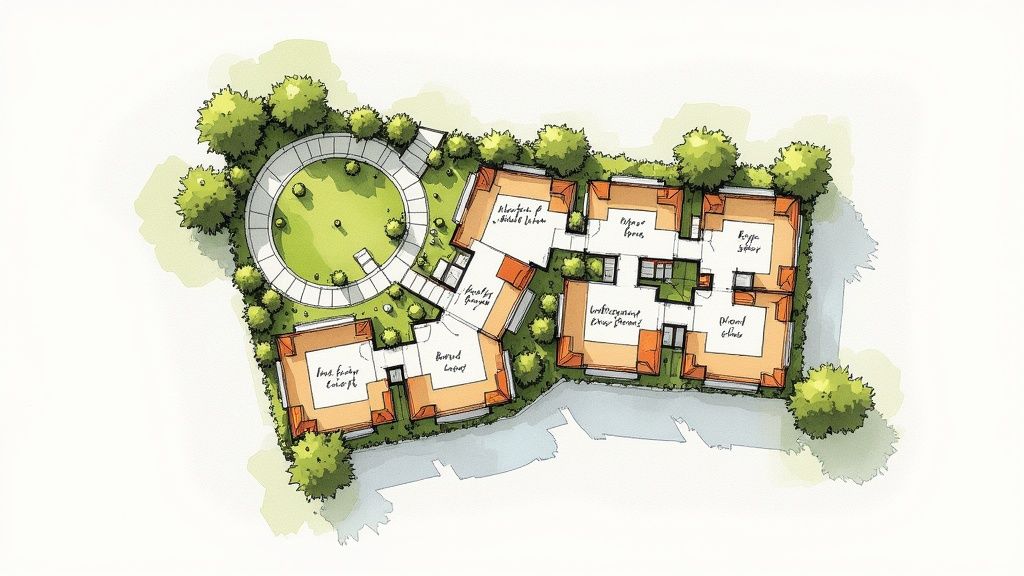
From a purely financial standpoint, cluster homes are a clever way to get into the landed property market. Because the land cost is shared among all the homes in the development, the price for each unit is typically much more approachable than a traditional, standalone house in the same area. This makes them a savvy investment, especially in the most desirable https://upperhouse.luxurycondo.sg/blog/neighbourhoods-in-singapore where a conventional landed property might be out of reach.
More Than Just a Home—It's a Lifestyle Upgrade
Beyond the attractive price point, it’s the day-to-day lifestyle that really sets cluster living apart. Residents get to enjoy a "lock-up-and-go" freedom that most landed homeowners can only imagine.
- Top-Notch Security: Most cluster developments are gated communities with 24/7 security. That extra layer of safety brings a real sense of peace of mind, especially for families.
- Hassle-Free Maintenance: Forget spending your weekends on landscaping, pool cleaning, or exterior paint jobs. All the common areas are professionally managed, giving you your free time back.
- A Real Community Feel: Shared facilities like pools, gyms, and BBQ pits naturally bring people together. Kids make friends easily, and neighbours become familiar faces, creating a tight-knit community atmosphere that’s hard to find elsewhere.
This unique blend of private space and shared amenities often translates to strong property values. It's not uncommon for cluster homes to command a higher price per square foot than even some conventional houses in the same area. Why? Because buyers are willing to pay a premium for the convenience, security, and sense of community that these developments offer.
The real magic of a cluster house is how it blends the best of both worlds. You get the spacious, private feel of a landed home combined with the effortless convenience of a modern condo. It's a living experience that’s not only financially smart but also deeply rewarding.
The Smart Design Philosophy Behind Cluster Housing
https://www.youtube.com/embed/GFOa2_3TR2k
At its core, a cluster house is more than just a luxurious home; it's a clever answer to a very modern problem: urban sprawl. This design philosophy deliberately groups homes together, pushing back against the old suburban ideal of a single house on an isolated plot of land.
Why do this? By clustering the residences, developers can free up vast, continuous areas of open green space for the entire community to enjoy. Think of it this way: instead of a dozen small, fenced-off backyards, you get expansive parks, winding nature trails, and shared gardens. This creates a living environment that feels more connected, sustainable, and frankly, more beautiful.
Maximizing Green Space and Efficiency
This intelligent approach to land use is a direct counter to inefficient development. Historically, cluster housing gained traction as a smart-growth strategy to combat unchecked suburban expansion. Simply grouping homes can cut down on hard, non-porous surfaces like driveways and roads by 20-30% compared to traditional layouts. This has a huge impact on improving stormwater drainage and reducing the "urban heat island" effect.
The design thinking behind cluster homes often borrows from green building concepts, like the Passive House Principles for sustainable design, to maximize efficiency. This focus on thoughtful, sustainable planning is a significant driver in the high-end property market. You can read more about these luxury real estate market trends in our other articles.
At its heart, the cluster house model is about creating more value from less land—more community, more nature, and a more sustainable footprint for everyone.
It's about reclaiming all those "in-between" spaces that are often wasted in a typical subdivision. By turning that wasted space into a valuable community asset, the quality of life for every single resident is enhanced. This is what makes the cluster house a truly modern and sought-after housing choice.
What to Know Before You Buy a Cluster House
So, you're considering a cluster house. It’s a fantastic choice, but it’s important to understand that you're not just buying a home; you're stepping into a unique community living arrangement. Getting a handle on the rules of the road is key to making sure it’s the right fit for you.
Let’s break down what that really means.
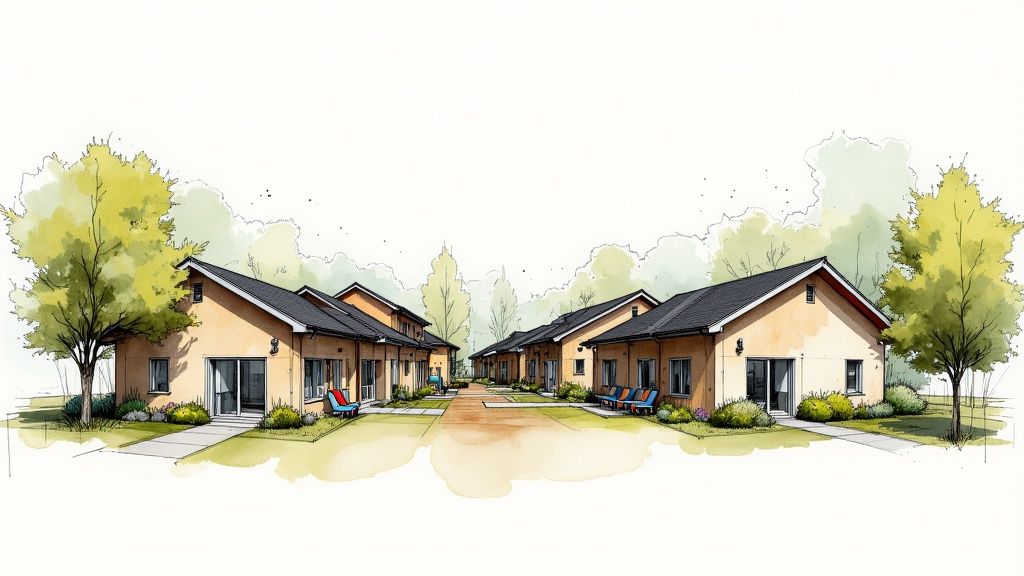
Unlike a typical landed property where you own the house and the land it sits on, cluster houses fall under a strata title. Think of it this way: you own your house, your personal space, from the walls in. But the land underneath, along with all the shared goodies—the pool, gym, gardens, and driveways—are co-owned with all your neighbours. It's a collective effort.
Understanding Your Responsibilities
This shared ownership model means everyone has a part to play. When you buy in, you automatically become a member of the Management Corporation Strata Title (MCST), which is essentially the homeowners' association that keeps the entire development running smoothly.
Here’s what that involves on your end:
- Paying Monthly Maintenance Fees: These are non-negotiable and absolutely vital. They cover everything from the security guards at the gate to landscaping, pool cleaning, and general upkeep of all the common areas.
- Following Community Rules: Every development has by-laws set by the MCST. These rules govern things like noise levels, pet policies, and when you can use the BBQ pits or swimming pool.
- Renovation Restrictions: Thinking of changing your windows or building a small extension? Not so fast. Any modifications to your home's exterior almost always need a green light from the MCST to ensure the whole estate maintains a consistent, attractive look.
You can think of the MCST as a mini-government for your neighbourhood. Its job is to protect everyone's investment by keeping the community well-maintained, safe, and pleasant for all residents.
When you're crunching the numbers for your purchase, don't forget the costs that go beyond the sticker price. You'll have legal fees and stamp duties to factor in. For instance, the Additional Buyer’s Stamp Duty can be a significant expense, so it pays to be prepared. Likewise, knowing how to calculate stamp duty is crucial for accurate financial planning.
Getting clear on these ownership rules and financial commitments from the start ensures there are no surprises, leaving you free to enjoy the incredible lifestyle a cluster home offers.
Got Questions About Cluster Houses? We've Got Answers
Thinking about a cluster house? It’s a unique type of home, so naturally, a few questions pop up. Let's tackle some of the most common ones that buyers have, so you can feel confident you’ve got all the facts.
Who Can Actually Buy a Cluster House?
This is a big one, especially for non-citizens. Cluster houses are a special category known as strata-titled landed properties, and that distinction is key.
Unlike a typical bungalow or terrace house, which is almost exclusively reserved for Singapore Citizens, foreigners sometimes get a chance to buy a cluster house. But it's not a free-for-all. Foreign buyers, and that includes Singapore Permanent Residents, need to get the green light from the Singapore Land Authority's (SLA) Land Dealings Approval Unit (LDAU). Each application is reviewed individually, and they tend to look favourably on people who have made significant economic contributions to the country.
Can My Furry Friend Move in Too?
For most of us, a home isn't complete without our pets. The good news is that cluster house developments are generally pet-friendly. However, the final say always comes down to the rules set by the community’s Management Corporation Strata Title (MCST).
Before you fall in love with a place, you absolutely must check its specific by-laws. You'll often find rules like:
- Size and Breed Limits: Some developments might have restrictions on how large your dog can be or may not allow certain breeds.
- Leash Rules: It's a near-universal rule that pets must be leashed in all common areas. No exceptions.
- Designated Pet Zones: To keep the beautifully manicured lawns clean for everyone, there might be specific areas for walking pets.
Your best bet? Always ask the managing agent for the official pet policy before you even think about making an offer.
How Do They Calculate the Maintenance Fees?
Ah, the maintenance fees. Also called MCST fees, this is a standard part of living in any strata-titled property, and it's what keeps the shared facilities looking pristine.
It all comes down to your property’s share value. A larger house gets a higher share value, which means it contributes a bit more to the maintenance fund. It’s a system designed for fairness—a bigger stake in the development means a proportionally bigger contribution.
So, what are you paying for? These fees cover everything from the security guards at the gate and the upkeep of the swimming pool to landscaping, gym maintenance, and even daily trash collection. Think of it as the price you pay for a hassle-free lifestyle where all the big (and small) maintenance jobs are handled for you.
Ready to explore a lifestyle that perfectly balances landed privacy with condominium convenience? Discover the pinnacle of luxury living at UPPERHOUSE at Orchard Boulevard, where every detail is crafted for an exceptional urban experience. Find your sanctuary in the heart of Singapore by visiting https://upperhouse.luxurycondo.sg.
Related Articles
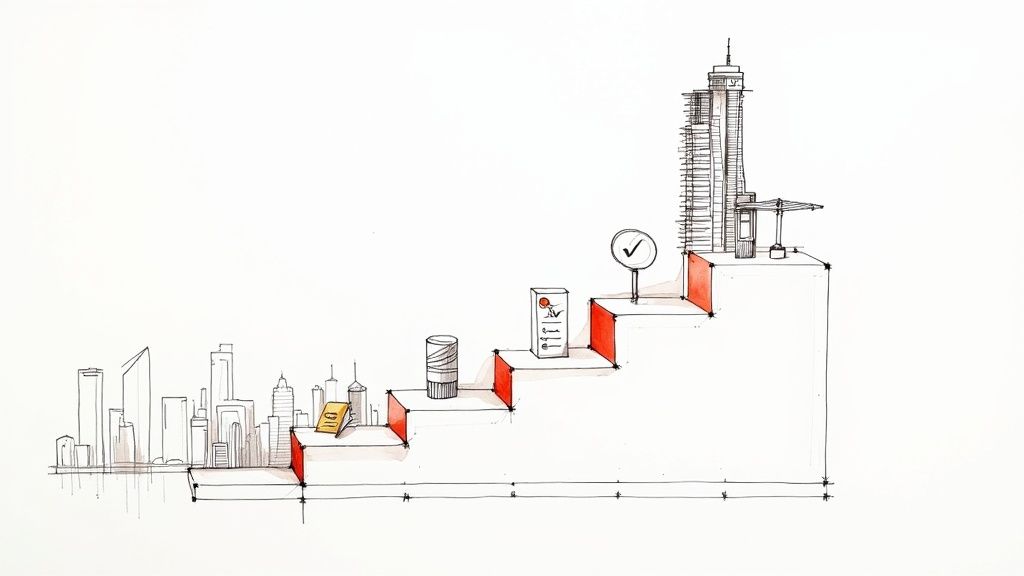
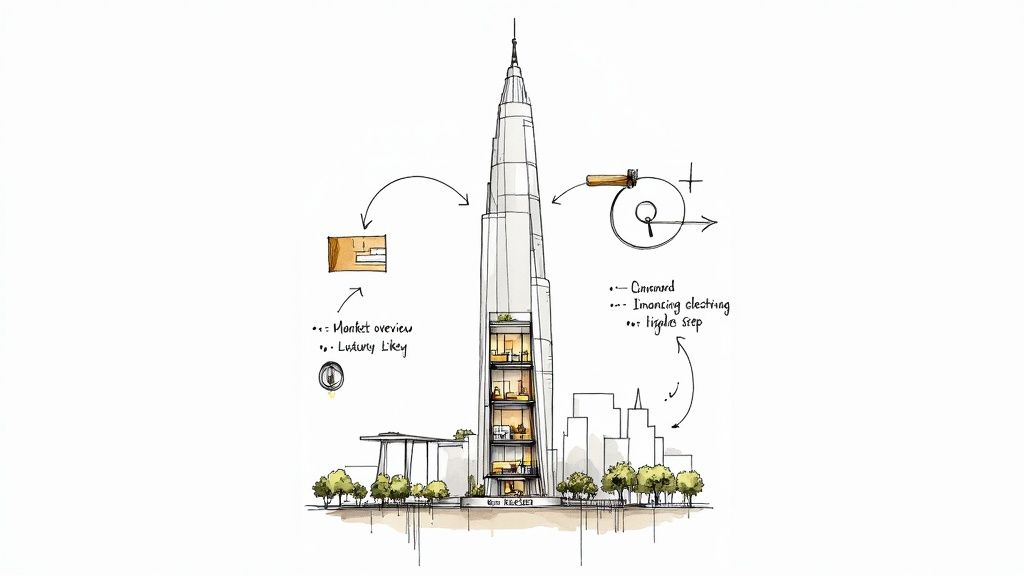

Interested in UPPERHOUSE?
Discover luxury living at UPPERHOUSE at Orchard Boulevard. Get exclusive updates and be the first to know about availability.